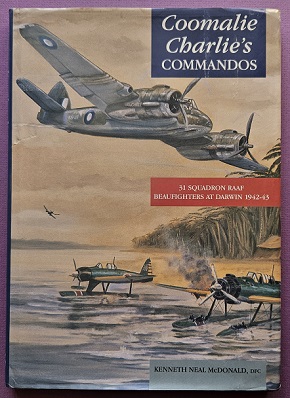Description
Title: Maritime is Number Ten – A History of No 10 Squadron RAAF: The Sunderland era, 1939 – 1945
Author: Baff, Kevin
Condition: Very Good Plus
Edition: 1st Edition
Publication Date: 1983
ISBN: 095923960X
Cover: Hard Cover without Dust Jacket – 466 pages
Comments: Previous owners ex libris label on the half title page. Celo tape marks on front and rear end pages where Celo tape has leaked into these pages. Discoloration to the page block
The detailed history of No 10 Squadron, RAAF. Inscription and signed on the half title page by the author.
No. 10 Squadron, Royal Australian Air Force was the only Australian squadron to serve continuously for the duration of the Second World War in Europe. Formed at Point Cook on 1 July 1939, 10 Squadron was initially equipped with a motley collection of seaplanes with the intention that these would shortly be replaced with six new Shorts Sunderland flying boats. At the end of July1939 a small group of squadron personnel proceeded to the United Kingdom for training on the new aircraft which, it was planned, they would then fly back to Australia. While these personnel were in Britain the Second World War was declared and on 7 October 1939 the Australian Government ordered the squadron to remain there to assist the British war effort.
The squadron was initially based at Pembroke Dock in Wales and was brought up to strength with drafts of personnel from Australia. Part of 15 Group, Coastal Command, it became operational on 1 February 1940. The squadron’s primary role throughout the war was to locate and destroy German submarines but its flying boats also proved useful for air-sea rescue and transport missions. In 1940 it predominantly escorted Allied convoys passing through the north-western Atlantic Ocean. The Bay of Biscay became the focus of the squadron’s operations in 1941, where it hunted German submarines moving from bases in France to the Atlantic. Its most intensive period of operations was during 1943. Numerous submarines were attacked in the bay, resulting in the sinking of two, but the squadron also lost seven aircraft. The squadron set a record for the number of patrol hours flown in a single month – 1143 – in February 1944 but by this time, submarine activity in the bay was on the decline. 10 Squadron returned to convoy escort duty in 1945.
The squadron’s two main bases were Pembroke Dock (October 1939 – April 1940, June 1941 – January 1942) and Mount Batten, near Plymouth in southern England (April 1940 – June 1941, January 1942 – October 1945) but small detachments also operated from Gibraltar (July – August 1940) and Oban in western Scotland (July 1940 – April 1941).
10 Squadron ceased operations on 1 June 1945, having sunk six submarines since February 1940. It was initially planned that it would redeploy to the Pacific theatre, but the war there ended before this occurred. 10 Squadron disbanded on 26 October 1945 but was destined to reform in 1949.
Includes Honours and awards, Squadron fatalities, Squadron U Boat claims, Detailed lists air sea rescue tasks, lists detailed aircraft on strength.




